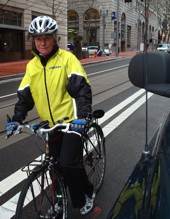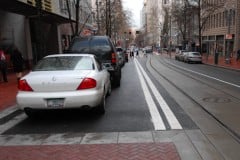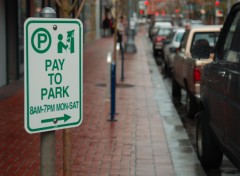
tricky tracks on the right.
(Photo © J. Maus)
This week, the City of Portland Bureau of Transportation decided to remove on-street parking on the new transit mall ahead of schedule due to safety concerns first brought to their attention by the Bicycle Transportation Alliance (BTA) back in October.
Concerned about the dangers posed by cars parked in the auto/bike travel lane, BTA advocate Michelle Poyourow called a meeting with TriMet and PBOT’s transit mall project manager Teresa Boyle to discuss the issue. In that October meeting, Poyourow expressed her concerns and urged TriMet and PBOT representatives to “remove parked cars from the travel lane immediately” and to not wait until the scheduled March 1st date.
“I just wish they would have gotten to the decision faster to save a few more people from crashing, but I know it was a hard decision to make.”
–Michelle Poyourow, BTA
Poyourow’s sense of urgency was spurred by a growing number of reports from riders who had crashed on light rail tracks on SW 5th and 6th Avenues in part due to being forced into the tracks to avoid parked cars.
One of those riders was Jan Schaeffer. Schaeffer, who works on SW 6th Avenue, crashed on the tracks between SW Taylor and SW Yamhill back in December when, as she puts it, she was forced to “weave into the trackway” because a parked car “plugged the lane”. (Coincidentally, Schaeffer was the City’s bike and pedestrian program manager. A post she held from 1977-1984).
In an email to me about her crash, Schaeffer wrote;

she got “squished” on SW 6th.
(Photo courtesy J. Schaeffer)
“I am a veteran bike commuter. I pay close attention to tracks. Until I crashed I assumed only novices fell victim to parallel tracks but I’ve learned that the conventional wisdom is wrong.”
Schaeffer said the problem is rampant. “There are at least three others in my office who have crashed,” she wrote,
“A man working in my building has a pin in his ankle. Several smokers who witnessed my crash said they’d seen several others fall.”
Luckily, Schaeffer didn’t sustain major injuries, but others have.
Another rider, who asked to remain anonymous, broke a rib and severely injured his collarbone in a crash on the tracks on SW 6th last August. He contacted BikePortland.org via email and wrote:
“I think that the new bike path that runs along the left is o.k., but it freaks me out that the cars are there.”

be free of parked cars.
(Photo © J. Maus)
With cars parked in the left lane (trains and buses operate on the right), bike riders are forced to occupy a narrow piece of road that sometimes comes withing a few feet of the rail tracks. (Once the mall project is completed, the left lane will be reserved for bike and auto traffic only and the parking will be removed, but the streets are currently open and are being used by bikes and cars already. Parking has already been removed on some portions of the mall due to bus training.)
At a follow-up meeting with PBOT project manager Teresa Boyle at the end of November, Poyourow thought she had made progress. “They said they would remove the parking at the end of the holidays…the first week in January instead of the first week in March.”
But after that meeting, Poyourow claims that Boyle made it clear to her that the parking removal couldn’t happen in that timeframe because three months of lost parking meter revenue would cost the City an estimated $55,000*.
Poyourow said her response to this was that the situation was already costing the city more than $55,000 in medical bills from crash victims, a sentiment echoed by Jan Schaeffer: “The city may be collecting $55,000 from parked cars, but we injured could easily be shelling out a similar amount.
When I reached Boyle to ask about the situation, she admitted that the parking meter revenue was indeed part of the decision to keep the parking. “That is a factor, yes,” she said,
“it’s revenue to us…we lost over 100 on-street spaces when the busses moved off the mall and onto 3rd and 4th and this (spaces on 5th and 6th) was an attempt to replace that inventory.”
Beyond simply a matter of lost revenue, Boyle says the parking issue has “been a balancing act the whole way,” and that much of the issue comes down to scheduling and availability of their maintenance crews.

all signs and meters gone by the
end of this month.
(Photo © J. Maus)
The Bureau of Maintenance (BOM) is needed to remove the parking meters and signage. Boyle says this issue is more about BOM crew availability (especially in light of our major storm) than lost revenue. I asked Boyle if it’s typical for BOM scheduling to influence policy decisions.
Why couldn’t PBOT just issue a memo and put up signs over the meters saying that parking was no longer allowed?
Boyle replied:
“To completely strip all of the parking from the lanes really makes it that much more difficult for our contractor to guarantee that those lanes would stay open. My preference was to do this in a way that moves the project forward without a hiccup.”
During my research on this story, I received word from Poyourow that PBOT decided to hasten their parking removal schedule. I confirmed this with Boyle who said,
“The good news is that we’ve confirmed with BOM that they will have it all removed by end of January. Barring unforeseen dumps of snow, (in which case BOM crews would have to respond) we’ll start seeing it come off next week.”
Boyle said their decision was in response to “the conversations we’ve been having about cyclists” with Michelle Poyourow.
Poyourow sees this as a unfortunate symptom of a “really starved transportation system”. When I spoke to her today from the BTA offices in Northwest Portland, she said she’s encouraged that PBOT acknowledged the problem and that it’s “good precedent” for them to weigh health and safety against revenue and schedules.
“I’m glad they ultimately made the right call,” she explained, “I just wish they would have gotten to the decision faster to save a few more people from crashing, but I know it was a hard decision to make.”
*According to PBOT parking officials, the $55,000 in lost parking meter revenue is an estimate based on average per space dollar amount, rather than a maximum rate (so the meter loss could actually be much greater). Sources for this story said SW 5th and 6th Avenues have a very high meter occupancy rate and that their are few empty meters to go to if meters are removed (therefore, people would use off-street private lots or garages — meaning lost revenue to the city.)
— Learn more about the new transit mall at PortlandMall.org.

